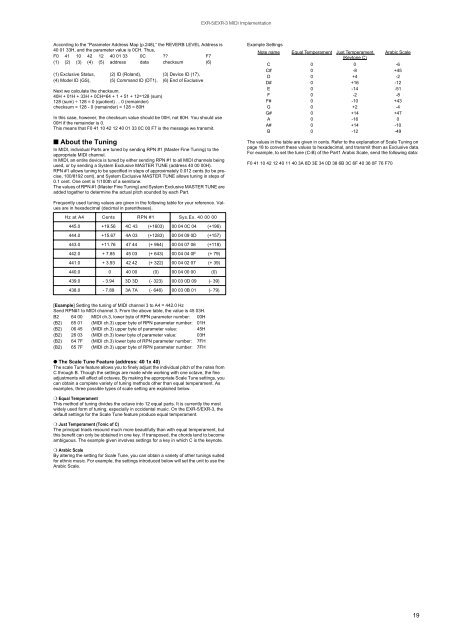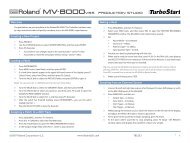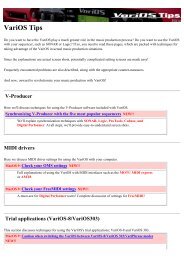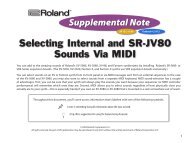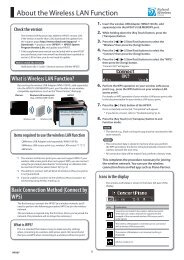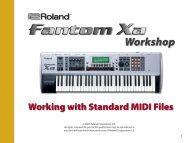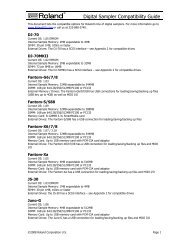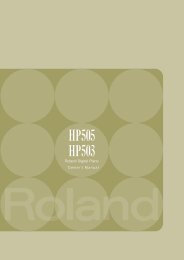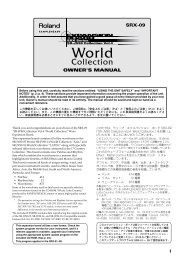EXR-5/EXR-3 MIDI Implementation - Roland
EXR-5/EXR-3 MIDI Implementation - Roland
EXR-5/EXR-3 MIDI Implementation - Roland
You also want an ePaper? Increase the reach of your titles
YUMPU automatically turns print PDFs into web optimized ePapers that Google loves.
<strong>EXR</strong>-5/<strong>EXR</strong>-3 <strong>MIDI</strong> <strong>Implementation</strong><br />
According to the “Parameter Address Map (p.248),” the REVERB LEVEL Address is<br />
40 01 33H, and the parameter value is 0CH. Thus,<br />
F0 41 10 42 12 40 01 33 0C ?? F7<br />
(1) (2) (3) (4) (5) address data checksum (6)<br />
(1) Exclusive Status, (2) ID (<strong>Roland</strong>), (3) Device ID (17),<br />
(4) Model ID (GS), (5) Command ID (DT1), (6) End of Exclusive<br />
Next we calculate the checksum.<br />
40H + 01H + 33H + 0CH=64 + 1 + 51 + 12=128 (sum)<br />
128 (sum) ÷ 128 = 0 (quotient) ... 0 (remainder)<br />
checksum = 128 - 0 (remainder) = 128 = 80H<br />
In this case, however, the checksum value should be 00H, not 80H. You should use<br />
00H if the remainder is 0.<br />
This means that F0 41 10 42 12 40 01 33 0C 00 F7 is the message we transmit.<br />
■ About the Tuning<br />
In <strong>MIDI</strong>, individual Parts are tuned by sending RPN #1 (Master Fine Tuning) to the<br />
appropriate <strong>MIDI</strong> channel.<br />
In <strong>MIDI</strong>, an entire device is tuned by either sending RPN #1 to all <strong>MIDI</strong> channels being<br />
used, or by sending a System Exclusive MASTER TUNE (address 40 00 00H).<br />
RPN #1 allows tuning to be specified in steps of approximately 0.012 cents (to be precise,<br />
100/8192 cent), and System Exclusive MASTER TUNE allows tuning in steps of<br />
0.1 cent. One cent is 1/100th of a semitone.<br />
The values of RPN #1 (Master Fine Tuning) and System Exclusive MASTER TUNE are<br />
added together to determine the actual pitch sounded by each Part.<br />
Example Settings<br />
Note name Equal Temperament Just Temperament Arabic Scale<br />
(Keytone C)<br />
C 0 0 -6<br />
C# 0 -8 +45<br />
D 0 +4 -2<br />
D# 0 +16 -12<br />
E 0 -14 -51<br />
F 0 -2 -8<br />
F# 0 -10 +43<br />
G 0 +2 -4<br />
G# 0 +14 +47<br />
A 0 -16 0<br />
A# 0 +14 -10<br />
B 0 -12 -49<br />
The values in the table are given in cents. Refer to the explanation of Scale Tuning on<br />
page 18 to convert these values to hexadecimal, and transmit them as Exclusive data.<br />
For example, to set the tune (C-B) of the Part1 Arabic Scale, send the following data:<br />
F0 41 10 42 12 40 11 40 3A 6D 3E 34 0D 38 6B 3C 6F 40 36 0F 76 F70<br />
Frequently used tuning values are given in the following table for your reference. Values<br />
are in hexadecimal (decimal in parentheses).<br />
Hz at A4 Cents RPN #1 Sys.Ex. 40 00 00<br />
445.0 +19.56 4C 43 (+1603) 00 04 0C 04 (+196)<br />
444.0 +15.67 4A 03 (+1283) 00 04 09 0D (+157)<br />
443.0 +11.76 47 44 (+ 964) 00 04 07 06 (+118)<br />
442.0 + 7.85 45 03 (+ 643) 00 04 04 0F (+ 79)<br />
441.0 + 3.93 42 42 (+ 322) 00 04 02 07 (+ 39)<br />
440.0 0 40 00 (0) 00 04 00 00 (0)<br />
439.0 - 3.94 3D 3D (- 323) 00 03 0D 09 (- 39)<br />
438.0 - 7.89 3A 7A (- 646) 00 03 0B 01 (- 79)<br />
[Example] Setting the tuning of <strong>MIDI</strong> channel 3 to A4 = 442.0 Hz<br />
Send RPN#1 to <strong>MIDI</strong> channel 3. From the above table, the value is 45 03H.<br />
B2 64 00 <strong>MIDI</strong> ch.3, lower byte of RPN parameter number: 00H<br />
(B2) 65 01 (<strong>MIDI</strong> ch.3) upper byte of RPN parameter number: 01H<br />
(B2) 06 45 (<strong>MIDI</strong> ch.3) upper byte of parameter value: 45H<br />
(B2) 26 03 (<strong>MIDI</strong> ch.3) lower byte of parameter value: 03H<br />
(B2) 64 7F (<strong>MIDI</strong> ch.3) lower byte of RPN parameter number: 7FH<br />
(B2) 65 7F (<strong>MIDI</strong> ch.3) upper byte of RPN parameter number: 7FH<br />
● The Scale Tune Feature (address: 40 1x 40)<br />
The scale Tune feature allows you to finely adjust the individual pitch of the notes from<br />
C through B. Though the settings are made while working with one octave, the fine<br />
adjustments will affect all octaves. By making the appropriate Scale Tune settings, you<br />
can obtain a complete variety of tuning methods other than equal temperament. As<br />
examples, three possible types of scale setting are explained below.<br />
❍ Equal Temperament<br />
This method of tuning divides the octave into 12 equal parts. It is currently the most<br />
widely used form of tuning, especially in occidental music. On the <strong>EXR</strong>-5/<strong>EXR</strong>-3, the<br />
default settings for the Scale Tune feature produce equal temperament.<br />
❍ Just Temperament (Tonic of C)<br />
The principal triads resound much more beautifully than with equal temperament, but<br />
this benefit can only be obtained in one key. If transposed, the chords tend to become<br />
ambiguous. The example given involves settings for a key in which C is the keynote.<br />
❍ Arabic Scale<br />
By altering the setting for Scale Tune, you can obtain a variety of other tunings suited<br />
for ethnic music. For example, the settings introduced below will set the unit to use the<br />
Arabic Scale.<br />
19


